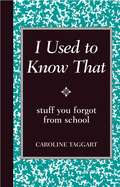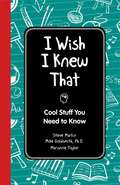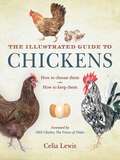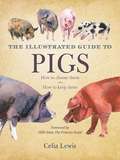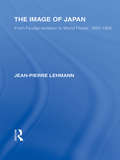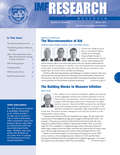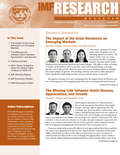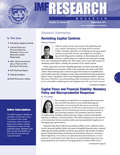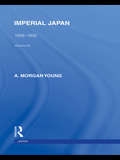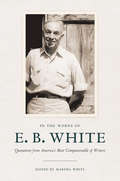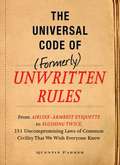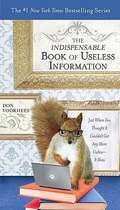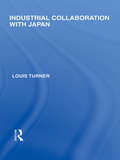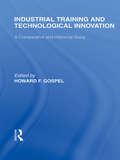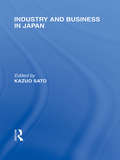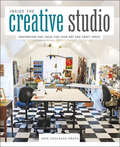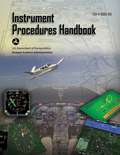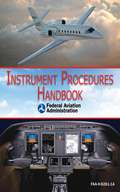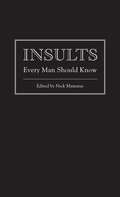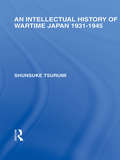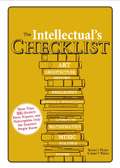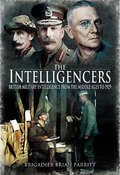- Table View
- List View
I Used to Know That
by Caroline TaggartThis small but mighty collection will trigger your memory with fun facts you learned in school-from adverbs to the Pythagorean Theorem. Witty, engaging, entertaining-a book you'll pick up again and again. Author Caroline Taggart discovered two things while researching this book and talking with other people: One, everybody had been to school. And two, they had all forgotten entirely different things. Contained in this handy little book are the facts that you learned in school, but may not remember completely or accurately. Covering a variety of subjects, this book features all the most important theories, equations, phrases, and rules we were all taught years ago. Rediscover: * History: The first president to occupy the White House was John Adams in 1800 * Religion: The seven deadly sins and the names of the twelve apostles * Literature: In which Shakespearean play "The quality of mercy" speech appears * Science: The periodic table of elements devised by a Russian chemist in 1889 includes the symbol for lead (Pb), silver (Ag), tin (Sn), and gold (Au) * Nature: How photosynthesis works The information-presented in easy-to-retain, bite-sized chunks-is accurate and up-to- date. It will touch a chord with anyone old enough to have forgotten half of what they learned at school. Here is a perfect gift for every perennial student.
I Wish I Knew That: Cool Stuff You Need to Know
by Steve Martin Dr Mike Goldsmith Marianne TaylorAn Apple a Day Keeps the Low Marks Away!<P><P> Have you ever been excited to find out you knew something the other kids in your class didn't? Then just think about how you would feel if you knew hundreds of fascinating tidbits-on everything from art, literature, and history to geography, science, and math-from just one quick-and-easy read crammed with fun and cool stuff you shouldn't have to wait to find out about. With I Wish I Knew That you will speed through science, whiz through history, and take a dip into the classic Greek and Roman myths in no time at all. Inside, learn all about... <P>* Classic Reads: A guide to classic children's literature such as Call of The Wild, Anne of Green Gables, The Wind in The Willows, Little Women and Shakespeare. <P>* How Land is Shaped and Changed: Erosion, Glaciers, Volcanoes and the world's tallest mountain, largest sea, and longest river. <P>* Math Stuff: Jump Into Geometry by learning that the three points of a triangle, whose angles always add up to 180º make measuring more precise. <P>* Science at a Glance: The Periodic table which was invented by Dmitri Mendeleyev and beginners' Biology <P>* History Stuff: Early explorers, important wars, all the Presidents and British Kings and Queens as well as the names of the countries and their capital cities. <P>* Bonus sections include Poet's Corner, Brief History of Music, The World Of Art and Geological Time, In Brief <P>With I Wish I Knew That you'll boost your general knowledge and jump to the head of the class!
The Illustrated Guide to Chickens: How to Choose Them, How to Keep Them
by Celia Lewis HRH The Prince Charles Prince Of WalesChickens are fun, useful, and easy to keep. If you have ever considered raising your own backyard flock, The Illustrated Guide to Chickens is the book for you! It offers practical advice and contains all the information you need to choose from one of the 100 most familiar breeds of chicken in North America and Europe to raise. Each breed's profile is written in engaging text that covers its history and main characteristics. You'll also find practical advice about poultry rearing and husbandry and the pros and cons of pure breeds, hybrids, bantams, game foul, and the like.
The Illustrated Guide to Pigs: How to Choose Them, How to Keep Them
by Celia LewisWith a resurgence of interest in raising animals, this delightfully illustrated and informative book is ideal for anyone who wants to choose the most suitable pig breed. The Illustrated Guide to Pigs covers thirty-eight of the most common breeds of pig in North America and Europe. Lewis has included helpful introductory sections with practical advice about pig rearing and husbandry, outlining the difference between the breeds. There are also practical sections on how to buy pigs, the equipment required to keep them, and advice on their basic care, feeding, and hygiene.
The Image of Japan: From Feudal Isolation to World Power 1850-1905 (Routledge Library Editions: Japan)
by Jean-Pierre LehmannJapan's image has experienced numerous transmutations. The book covers the metamorphosis from Japan's image of a feudal, exotic and romantic land inhabited by Madam Butterflies, to its sudden emergence as a geopolitical power following its defeat of Russia in 1905. More was to come. In the 1930s and 40s the image of the kamikaze vividly illustrated the fanaticism and barbarity associated with Japan in World War II. With the 1964 Tokyo Olympics, Japan rejoined the international community as a friend and ally of the US. The next transmutation came in the 1980s when the Japanese economy appeared to be functioning on anabolic steroids and its continued ascent to take over the US was predicted. "Japanese management" became more than a science, almost a religion, among business schools and consultancies. Today there are two images: one is conveyed through manga, karaoke and the global fashion for sushi; the other is of an economically and demographically declining nation. Will this image correspond to Japan's swan song or are there more transmutations on the way? One constant in Japanese history and the image it has projected has been the country's constant ability to surprise.
Imperial Japan: 1926-1938 (Routledge Library Editions: Japan)
by A Morgan YoungA journalist on the Japan Chronicle for eleven years, the author collected in this volume the most significant current events for discussion. They include the financial crisis of 1927, hostilities with China and in particular Manchuria, Japan’s booming manufacturing industry, Japanese nationalism, Japan’s new empire and its place within the Far East and East Asia. Written from a Western perspective, the volume nonetheless presents a balanced view of Japan and its behaviour which only close observation and dealings with the Japanese people could make possible.
In the Words of E. B. White: Quotations from America's Most Companionable of Writers
by E. B. White"The time not to become a father is eighteen years before a world war."—E. B. White on fatherhood"I was lucky to be born abnormal. It ran in the family."—on luck"I would really rather feel bad in Maine than feel good anywhere else." —on Maine"The English language is always sticking a foot out to trip a man."—on language The author of Charlotte's Web and One Man's Meat, coauthor of The Elements of Style, and columnist for The New Yorker for almost half a century, E. B. White (1899–1985) is an American literary icon. Over the course of his career, White inspired generations of writers and readers with his essays (both serious and humorous), children's literature, and stylistic guidance. In the Words of E. B. White offers readers a delightful selection of quotations, selected and annotated by his granddaughter and literary executor, Martha White. The quotations cover a wide range of subjects and situations, from Automobiles, Babies, Bees, City Life, and College to Spiders, Taxes, Weather, Work, and Worry. E. B. White comments on writing for children, how to tell a major poet from a minor one, and what to do when one becomes hopelessly mired in a sentence. White was apt to address the subject of security by speaking first about a Ferris wheel at the local county fair, or the subject of democracy from the perspective of roofing his barn and looking out across the bay—he had a gift for bringing the abstract firmly into the realm of the everyday. Included here are gems from White's books and essay collections, as well as bits from both published and unpublished letters and journals. This is a book for readers and writers, for those who know E. B. White from his "Notes and Comment" column in The New Yorker, have turned to The Elements of Style for help in crafting a polished sentence, or have loved a spider's assessment of Wilbur as "Some Pig." This distillation of the wit, style, and humanity of one of America's most distinguished essayists of the twentieth century will be a welcome addition to any reader's bookshelf.
The Incontrovertible Code of (Formerly) Unwritten Rules
by Quentin ParkerNever hog both armrests when you fly.Doorways, staircases, and elevator entrances are inappropriate spots to stop and chitchat.Always remember that one's own poop does, in fact, stink.When you borrow someone's car, fill it up with gas before you give it back.These are the unwritten rules of life. Observe them, and one rises above the great unwashed. Observe them not, and one goes straight to trailer trash.In this hilariously civil guide, you'll learn all of the principles of politesse our mothers tried to teach us--but some of us just weren't listening. So listen up, because our mothers were right: Handsome is as handsome does. If you never really understood what that meant--and who did?--then this book is for you. The Universal Code of (Formerly) Unwritten Rules: Because some rules should never be broken.
The Incontrovertible Code of (Formerly) Unwritten Rules: From Airline- Armrest Etiquette to Flushing Twice, 251 Universal Laws of Common Civility that We Wish Everything Knew
by Quentin ParkerNever hog both armrests when you fly.Doorways, staircases, and elevator entrances are inappropriate spots to stop and chitchat.Always remember that one's own poop does, in fact, stink.When you borrow someone's car, fill it up with gas before you give it back.These are the unwritten rules of life. Observe them, and one rises above the great unwashed. Observe them not, and one goes straight to trailer trash.In this hilariously civil guide, you'll learn all of the principles of politesse our mothers tried to teach us--but some of us just weren't listening. So listen up, because our mothers were right: Handsome is as handsome does. If you never really understood what that meant--and who did?--then this book is for you.The Universal Code of (Formerly) Unwritten Rules: Because some rules should never be broken.
The Indispensable Book of Useless Information
by Don VoorheesNothing you'll ever need to know is in this book The #1 New York Times bestselling series continues to prove that there are plenty of things in this world no one needs to know about. Why bother learning that. . . * Poland sells a drink called Fart Juice? * ATMs in Vatican City are in Latin? * a two-year-old learns about ten new words a day? * President George Washington checked out two library books that are now 220 years overdue? Do you really need to know. . . * how many clocks are in the Pentagon? * which state has towns called Intercourse and Virginville? * what WD-40 stands for? * the state with the fastest drivers?
Industrial Collaboration with Japan (Routledge Library Editions: Japan)
by Louis TurnerThis study looks at the experiences of European and American companies that have collaborated with their Japanese competitors in the fields of computers, consumer electronics, automobiles and aero-engines, by forming joint ventures, designing products together and pursuing complementary marketing strategies. It examines why these companies have chosen to collaborate rather than compete; whether the Japanese companies have proved to be reliable partners; whether the non-Japanese have been left behind; and what the future of such collaboration may be. The book concludes by pointing to a growing interest among non-Japanese companies in investing and collaborating within Japan itself.
Industrial Training and Technological Innovation: A Comparative and Historical Study (Routledge Library Editions: Japan)
by Howard F. GospelTaking an international and comparative perspective, this book focuses on the relationship between industrial training and technological change in three major global economies – the UK, USA and Japan. The contributors, an international group of leading researchers, look at the origins and development of training in these countries, and analyse the benefits resulting from the interaction of a skilled workforce and technological change. This analysis of training in major industrial nations reveals the full complexity of the relationship between labour and technological change. It shows the value of an approach which is both historical and comparative, and highlights the importance of education and training as a necessary basis for successful innovation.
Industry and Business in Japan (Routledge Library Editions: Japan)
by Kazuo SatoThis volume analyzes Japan’s industrial organization both from a historical perspective and by looking in details at specific industries such as iron, steel and the automotive industry. Big business, business groups and industrial policy are also discussed. The volume also provides a survey of the literature in Japanese which will help the reader in search of original sources.
Inside the Creative Studio: Inspiration and Ideas for Your Art and Craft Space
by Cate Coulacos PratoInside the Creative Studio is your ticket to turn your vision of a dream studio space into a reality.The professional artists and crafters of Studios Magazine give you the tools to create your own one-of-a-kind artistic environment in this best-of compilation. Learn how to find space in your home, whittle down your stash, maximize your storage and organization possibilities, and manage your stash of supplies and equipment to keep your work space functional and fun to work in. Experts will also show you how to repurpose furniture, integrate recyclables, and showcase vintage items to establish a space with purpose and personality. You will spend less time struggling with your studio, or lack thereof, and more time actually creating in your unique space.Regardless of your time, money, or space, Inside the Creative Studio offers charming and innovative solutions for every lifestyle. Artists and crafters of all types, including quilters, fiber artists, mixed-media artists, jewelry makers, sewists, painters, writers, bloggers, and more, share their stories, tips, and studios. Beautiful photographs and friendly dialogue walk you through these active spaces as if you were getting your own private tour. From spacious oases to cute and compact retreats, each space offers countless inspirational ideas.With some of the best articles and creative inspiration from Studios Magazine, Inside the Creative Studio offers everything you need to know to spend less time fussing with your space and more time enjoying your creative work.
Instrument Procedures Handbook: FAA-H-8083-16A (FAA Handbooks Ser.)
by Federal Aviation AdministrationThis is the new 2015 edition of the FAA's previous "Instrument Procedures Handbook" (previously the FAA-H-8083-16).This book covers all of the information needed to operate safely within the airspace system. In the FAA's "Instrument Procedures Handbook" (#FAA-H-8083-16A) the emphasis is placed on operations and procedural information for real-world use, which makes this the next logical step for pilots after learning basic instrument skills from the FAA's "Instrument Flying Handbook" (#FAA-H-8083-15B). Using this book, pilots can more directly apply the concepts to their current flying situation, and learn how their acquired skills are best used in today’s IFR environment. Considered industry-wide as a top source for instrument procedures information and a "must read” for all instrument pilots, this new 2015 edition brings pilots the latest changes to procedures and even more insights and guidance on how to operate safely within the national airspace system. Detailed information is provided for every navigation receiver and phase of flight on the required precision necessary to stay within protected airspace and to make a successful approach.While it was designed as a reference for professional pilots, the specialized glossary, index, full-color illustrations and photographs in this book make it a valuable training aid for flight instructors, instrument pilots, and instrument students alike. Each topic covered is well-detailed and explained in user-friendly terms, along with full-color depictions to aid understanding.Instrument flight instructors, pilots, and students will need this resource since it is used as a reference for the Airline Transport Pilot and Instrument Knowledge Tests and for the Practical Test Standards. Whether a pilot is a seasoned professional or recently completed an Instrument Rating course, this FAA handbook is sure to encourage more precise instrument techniques and ultimately create a safer pilot.
Instrument Procedures Handbook: Faa-h-8083-16a (FAA Handbooks Ser.)
by Federal Aviation AdministrationDesigned as a technical reference for instrument-rated pilots who want to maximize their skills in an "Instrument Flight Rules” environment, this revised and up-to-date edition of the Federal Aviation Administration’s Instrument Procedures Handbook contains the most current information on FAA regulations, the latest changes to procedures, and guidance on how to operate safely within the National Airspace System in all conditions. Featuring an index, an appendix, a glossary, full-color photos, and illustrations, Instrument Procedures Handbook is the most authoritative book on instrument use anywhere.
Insults Every Man Should Know (Stuff You Should Know #7)
by Nick MamatasHard-Hitting Insults for Every OccasionIncluding * Insulting Someone's Intelligence * Insulting Someone's Sexual Prowess * Insults for the Office * Insults on Game Day * Insults throughout History * Insults from around the WorldPlus insulting gestures, backhanded compliments, comebacks, all the things you should never say about someone's mama, and much more!From the Hardcover edition.
An Intellectual History of Wartime Japan: 1931-1945 (Routledge Library Editions: Japan)
by Shunsuke TsurumiWhen this book was published in Japanese in 1982 it was awarded the prestigious Jiro Osaragi Prize. It is an important contribution to the understanding of the mental and spiritual world of Japan just over two generations ago. The author argues that just as the period of isolation up to the middle of the 19th century was crucial for Japan’s development, so the Second World War represented another crucial period for the country. These years were a period of intellectual isolation during which significant development took place.
The Intellectual's Checklist
by James V. Wallace Richard J. WallaceCan you name: All five movements of Beethoven's Missa solemnis. Check. The films that Kurosawa based on Western works. Check. Dante's Nine Circles of Hell. Check. If so, you're off to an edifying start--but that's just round one in this hard-hitting match of wits and wisdom. Take the formidable plunge--and find out if you are truly well versed enough to call yourself an aspiring pundit, poet, and philosopher. Either way, you'll be worthy of the esteemed moniker intellectual by the time you've gone the distance with this book. (As Thoreau is our witness.) Whether you are just beginning to suspect you're the possessor of superior acumen or you'd bet your Homeric Greek translation of The Iliad on it, this book is an essential addition to any personal library.
The Intellectual's Checklist
by Richard J WallaceCan you name:All five movements of Beethoven's Missa solemnis. Check.The films that Kurosawa based on Western works. Check.Dante's Nine Circles of Hell. Check.If so, you're off to an edifying start--but that's just round one in this hard-hitting match of wits and wisdom. Take the formidable plunge--and find out if you are truly well versed enough to call yourself an aspiring pundit, poet, and philosopher. Either way, you'll be worthy of the esteemed moniker intellectual by the time you've gone the distance with this book. (As Thoreau is our witness.)Whether you are just beginning to suspect you're the possessor of superior acumen or you'd bet your Homeric Greek translation of The Iliad on it, this book is an essential addition to any personal library.
The Intellectual's Checklist
by Richard J. Wallace James V. WallaceAll five movements of "Beethoven's Missa" solemnis. Check. The films that Kurasawa based on Western works. Check. Dante's "Nine Circles of Hell". Check. These are the sorts of elegant erudition every self-respecting intellectual should know - inside and out. In "The Intellectual's Checklist", aspiring pundits, poets, and philosophers find the arcane checklists that reveal whether they are truly well-versed enough in the arts and sciences of the obscure to warrant the esteemed moniker "Intellectual". From Nietzsche to Newton, Einstein to Eisenstadt, Sappho to Sartre, this elucidating volume gives readers all the esoterica they need to bask in the knowledge that they really do know everything. (Now that they've read this book. )
The Intelligencers: British Military Intelligence From the Middle Ages to 1929
by Brian ParrittIntelligence about the enemy is a fundamental part of any war or battle; knowledge of the enemys strength, dispositions and intentions are essential for success. This book reveals that for 250 years the British Army resolutely failed to prepare for war by refusing to establish a nucleus of soldiers in peace, trained to obtain intelligence in war. Although there were Scoutmasters and secret spy organizations such as Walsinghams in the 15th Century, in no major conflict from the Civil War of 1642, including the Peninsula, the Crimea, Burma, Egypt and South Africa and in the multitude of small wars that gained Britain an empire, was there any staff branch or unit specifically pre-established to gain intelligence or frustrate the enemy from obtaining intelligence. Yet the story of British military endeavor over 250 years is a remarkable story of individuals bravery, achievement and success. We read of the Scoutmaster whose role was to gather intelligence on the Kings enemies and of Walsinghams secret organization at the time of Elizabeth I. During the long years of war against France culminating in the Napoleonic Wars, spy masters developed on an ad hoc basis. In the Nineteenth Century, despite the power and reach of Empire, no central intelligence organization existed. Enterprising young officers worked wonders but failures such as those in the Boer War cost the Nation dearly. It took the reverses in the Great War to create an Intelligence Corps. But even that was disbanded postwar.
